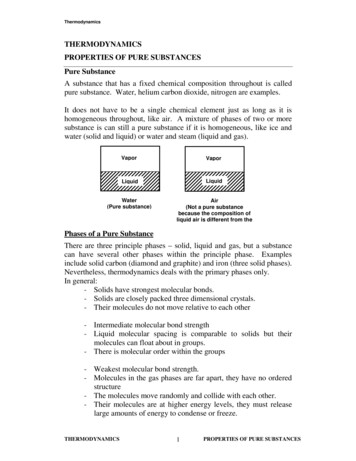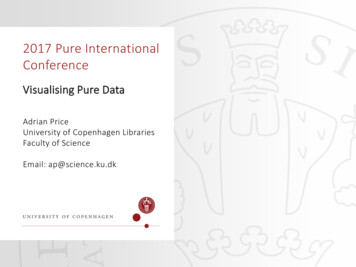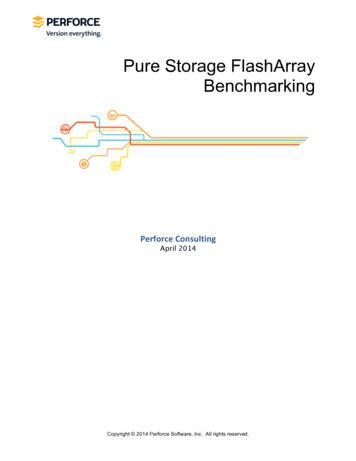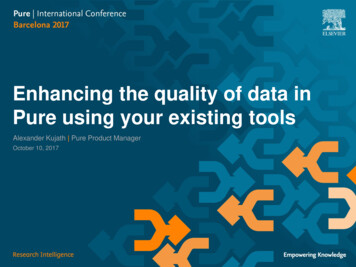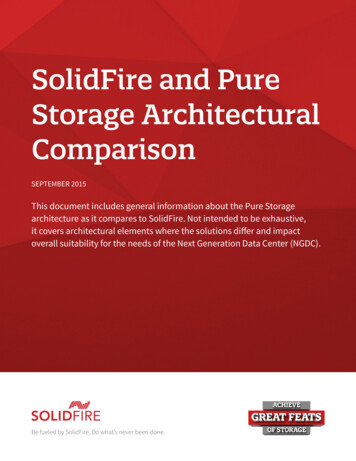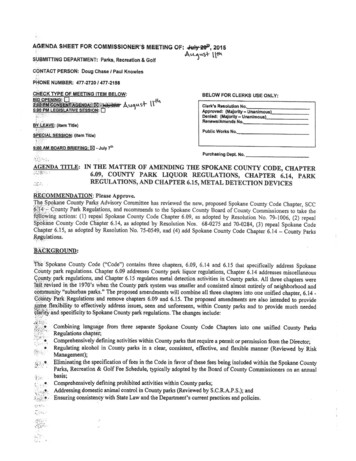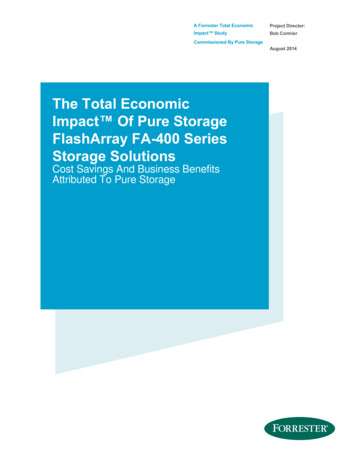
Transcription
A Forrester Total EconomicProject Director:Impact StudyBob CormierCommissioned By Pure StorageAugust 2014The Total EconomicImpact Of Pure StorageFlashArray FA-400 SeriesStorage SolutionsCost Savings And Business BenefitsAttributed To Pure Storage
Table Of ContentsExecutive Summary . 1Disclosures . 2TEI Framework And Methodology . 3Analysis . 4Financial Summary . 16Appendix A: About Pure Storage FlashArray FA-400 Series:Overview . 17Appendix B: Total Economic Impact Overview . 19Appendix C: Glossary . 20ABOUT FORRESTER CONSULTINGForrester Consulting provides independent and objective research-basedconsulting to help leaders succeed in their organizations. Ranging in scope from ashort strategy session to custom projects, Forrester’s Consulting services connectyou directly with research analysts who apply expert insight to your specificbusiness challenges. For more information, visit forrester.com/consulting. 2014, Forrester Research, Inc. All rights reserved. Unauthorized reproduction is strictly prohibited.Information is based on best available resources. Opinions reflect judgment at the time and are subject tochange. Forrester , Technographics , Forrester Wave, RoleView, TechRadar, and Total Economic Impactare trademarks of Forrester Research, Inc. All other trademarks are the property of their respectivecompanies. For additional information, go to www.forrester.com.
1Executive SummaryIn the summer of 2014, Pure Storage commissionedForrester Consulting to conduct a Total EconomicImpact (TEI) study to examine the potential return oninvestment (ROI) enterprises may realize by deployingPure Storage FlashArray FA-400 Series storagesolutions. The purpose of this study is to providereaders with a framework to evaluate the potentialfinancial impact of Pure Storage within theirorganizations.Quantified benefit categories of PureStorage FA-400 Series FlashArrays(risk- and present value-adjusted over three years) Business benefits — 1,284,614. Simplification of deployment and managementtasks savings — 171,150. Simplification — storage health checks - costavoidance savings — 22,762. Data center rack space cost avoidance savingsTo better understand the benefits, costs, and risks— 238,036.associated with an investment in Pure Storage, Power and cooling savings — 85,719.Forrester conducted in-depth interviews with four Pure Software license and maintenance — costStorage customers. For a brief description of eachavoidance savings — 106,364.customer, see the Analysis section. According to PureStorage, its FlashArray FA-400 Series is an economicalall-flash storage solution for virtually any workload.Purity is the Pure Storage operating environment built from the ground up for flash. Purity is provided at no additional costwith every FlashArray and runs consistently across the entire FlashArray hardware family. For more details on the PureStorage solution, see Appendix A.Forrester created a composite Organization to describe the TEI of Pure Storage. This composite Organization is a global,midmarket ( 100 million to 1 billion) enterprise that distributes and services its products. It is headquartered and hasoperations in North America with multisite operations in EMEA and APAC. Forrester has projected costs and benefits overthree years in this study. For more information, see the section titled: The Composite Organization.PURE STORAGE’S SOLUTION PROVIDED SIGNIFICANT CAPITAL AND OPERATIONAL COST SAVINGSOur interviews and subsequent financial analysis found that the composite Organization experienced the risk-adjusted ROI,benefits, and costs shown in Figure 1.The analysis points to risk-adjusted benefits of 1,908,644 over three years versus implementation and operating costs of 946,792, equating to a net present value (NPV) of 961,852. The risk-adjusted ROI was a very favorable 102%.FIGURE 1Financial Summary Showing Three-Year Risk-Adjusted ResultsROI:102%Source: Forrester Research, Inc.Benefits PV: 1,908,644Costs PV: 946,792NPV: 961,852
2Though the price per raw gigabyte (GB) of flash storage is more expensive than hard drive storage, a growing number of usecases have developed where the performance, resiliency, and ROI of flash can outweigh the higher acquisition costs. This isdue to data reduction features such as deduplication and compression where the usable per GB cost is the same or lessexpensive in almost all use cases except for low data reduction applications such as video. The four interviewed customersreported that Pure Storage FlashArrays had a major beneficial impact on the infrastructure operations of their organizations.In addition, the performance benefits of Pure Storage FA-400 Series have business benefits that transcend the data centerand have a positive impact on the Organization. The following are the benefits quantified in this case study:››Total benefits associated with Pure Storage FlashArray FA-400 Series storage solutions — 1,908,644. TheOrganization experienced the following benefits (risk- and present value-adjusted) over three years (further detailed in theBenefits: Quantified section): Business benefits — 1,284,614. Simplification of deployment and management tasks savings — 171,150. Simplification — storage health checks — cost avoidance savings — 22,762. Data center rack unit cost avoidance savings — 238,036. Power and cooling savings — 85,719. Software license and maintenance — cost avoidance savings — 106,364.Costs associated with Pure Storage — 946,792. The Organization experienced the following costs (present valueadjusted) over three years (further detailed in the Costs section): Planning and deploying Pure Storage — 5,384. This is the labor associated with planning and deploying thesolution. Pure Storage costs —- 924,000 Professional services and training — 0 (zero dollars). No professional services or training is required. Ongoing labor to manage Pure Storage — 17,408.If the risk-adjusted NPV of costs and benefits still demonstrates a compelling business case, it raises confidence that theinvestment is likely to succeed because the risks that threaten the project have been taken into consideration and quantified.The risk-adjusted numbers should be taken as “realistic” expectations, as they represent the expected values consideringrisk. Assuming normal success at mitigating risk, the risk-adjusted numbers should more closely reflect the expectedoutcome of the investment.DisclosuresThe reader should be aware of the following:››››The study is commissioned by Pure Storage and delivered by Forrester Consulting. It is not meant to be used as acompetitive analysis.Forrester makes no assumptions as to the potential return on investment that other organizations will receive. Forresterstrongly advises that readers use their own estimates within the framework provided in the study to determine theappropriateness of an investment in Pure Storage.Pure Storage reviewed and provided feedback to Forrester, but Forrester maintained editorial control over the study and itsfindings and did not accept changes to the study that contradict Forrester’s findings or obscure the meaning of the study.The interviewed customers’ names were provided by Pure Storage. Pure Storage did not participate in the interviews.
3TEI Framework And MethodologyINTRODUCTIONFrom the information provided in the interviews, Forrester has constructed a Total Economic Impact (TEI) framework forthose organizations considering investing in Pure Storage. The objective of the framework is to identify the benefits, costs,flexibility, and risk factors that affect the investment decision.APPROACH AND METHODOLOGYForrester employed four fundamental elements of TEI in modeling Pure Storage: benefits, costs, flexibility, and risks.Forrester took a multistep approach to evaluate the impact that Pure Storage can have on the composite Organization (seeFigure 2). Specifically, we:››››Interviewed Pure Storage marketing, sales, and product management personnel, along with Forrester storage analysts, tobetter understand the value proposition for Pure Storage.Conducted in-depth interviews with each of the four customers to obtain data with respect to costs, benefits, and risks.Constructed a financial model representative of the interviews using the TEI methodology. The financial model ispopulated with the cost and benefit data obtained from the interviews.Risk-adjusted the financial model based on issues and concerns the customers raised in the interviews. Risk adjustment isa key part of the TEI methodology. While the interviewed customers provided cost and benefit estimates, some categoriesincluded future projections or a broad range of responses, or had a number of internal or external forces that might haveimpacted costs and benefits higher or lower. For that reason, each benefit has been risk-adjusted and is detailed in theBenefits: Quantified section.Given the increasing sophistication that enterprises have regarding ROI analyses related to IT investments, Forrester’s TEImethodology serves to provide a complete picture of the total economic impact of purchase decisions. Please see AppendixB for additional information on the TEI methodology.FIGURE 2TEI ApproachPerformdue diligenceSource: Forrester Research, zationConstructfinancialmodel usingTEI frameworkWritecase study
4AnalysisINTERVIEWED CUSTOMERSForrester derived its conclusions in large part from information received in a series of in-depth interviews we conducted withexecutives and personnel at four customers, each of which had deployed Pure Storage’s FlashArray FA-400 Series storagesolutions in production for between six and 10 months. The following is a brief description of the interviewed customers, all ofwhich were promised anonymity:››››A US-based cloud-based software-as-a-service (SaaS) business applications company with about 100 million in annualrevenues. It has been using four Pure Storage FA-420 arrays for nine months. Previously, it had FA-320 hardware. It isusing Pure Storage for the following environments: VMware, virtual desktop infrastructure (VDI), Oracle database, andSQL Server database. Forrester interviewed the vice president of IT and a senior IT manager.A US-based 200 million provider of solutions to research markets. It has been using one Pure Storage FA-420 array forOracle database reporting and one FA-320 array for test and development for nine months. Forrester interviewed thedirector of IT, infrastructure, and operations.A warehousing and logistics company with over 2,000 employees and based and operating in the US. It purchased twoFA-420s 10 months ago for its VMware and SQL server environments. Forrester interviewed the manager of technicalservices.A multibillion-dollar global financial services company. It has invested in six FA-420 arrays deployed in its VMware and VDIenvironments. Forrester interviewed the director of storage management.THE COMPOSITE ORGANIZATIONThe composite Organization is a global, midmarket ( 100 million to 1 billion) enterprise that manufactures, distributes, andservices its products. It is headquartered and has operations in North America. It has been using Pure Storage for one yearto support storage needs in the following environments: VMware, VDI, Oracle database, and SQL Server database.The performance requirements of the Organization’s virtualization platforms and enterprise applications are rapidlyincreasing, which has forced its data center and storage administrators to rethink their storage environments with a goal ofaccelerating the technology transition from hard drives to flash-based storage.After a review process evaluating several vendors, the Organization selected Pure Storage FA-420 arrays (two arrays), as itbelieves Pure Storage can satisfy the following business challenges, goals, and objectives:››››Capex cost reduction. The Organization was adding additional virtual host servers and storage capacity to circumventthe performance degradation and inefficiencies in its legacy storage area network (SAN). The goal was to find a newsolution to support the Organization’s growing virtual environment at a lower overall capital cost and without sacrificingperformance.Opex cost reduction. The Organization wanted to reduce costs for power and cooling and the following administrativetasks: initial storage deployment, growing and shrinking volumes, monitoring capacity and performance, managing hostsand host groups, and managing snapshots.Simplicity. Storage administration must be simpler than its legacy storage for both implementation and ongoingadministration.Latency. It needed predictable submillisecond latency for its applications. Its legacy storage had unacceptably highlatency ranging from 12 milliseconds to 25 milliseconds.
5››Performance. Its legacy mechanical spinning disk storage was becoming increasingly slow and unable to keep up withgrowing performance demands.Resiliency. Its next storage system had to include nondisruptive features for capacity expansion, controller upgrades, andsoftware updates, keeping data safe, secure, and available without performance loss.The Organization invested in the following Pure Storage solutions that should satisfy its storage growth needs for the nextthree years:››FA-420-34TB (34TB raw, 125 TB effective capacity) FlashArray and includes Premium Support (4-hour on-site hardwarereplacement).FA-420-11TB (11TB raw, 40 TB effective capacity) FlashArray and includes Premium Support (4-hour on-site hardwarereplacement).According to Pure Storage, the FA-420 array continues to be the center of the FlashArray family, suitable for acceleratingconsolidated applications with up to 125 TB of usable space. The FA-420 can be nondisruptively upgraded to an FA-450system as a customer’s capacity or performance needs increase. The FA-400s can also be nondisruptively upgraded toPure Storage’s next-generation systems in the future, in the same fashion that the FA-320 was upgradable to the FA-420when it became available on the market.BENEFITS: QUANTIFIEDThough performance is the main goal that organizations have when they deploy flash storage, the interviewed customersfound economic validation for their investment in a variety of ways. This is a key point to keep in mind since some of thecustomers Forrester interviewed found great value in specific areas, such as rack space and power savings. Othercustomers found that this benefit was relatively insignificant compared with other benefits, such as the capital expensesavings and the ease of use of Pure Storage’s Purity operating system. One customer cited the ability to meet service-levelagreements (SLAs) and avoidance of costly penalties or the loss of business, which would not have been possible withoutflash storage. Forrester was able to quantify the following six benefit categories.Business Benefits With Pure Storage FA-400 Series FlashArraysPure Storage customers had at least one example of incremental business benefits associated with Pure Storage. Here aresome of the examples:›››››A faster overnight refresh of its data mart using Pure StorageFlashArrays. There was a need to shrink that overnight window soits Asia offices could run reports during their business hours. Therefresh window was reduced from over 3 hours (legacy storage) to82 minutes with Pure Storage.Payroll for one company running 250 transactions at a time when itused to be 30 at a time, an eightfold improvement.Large SQL jobs running in seven days with Pure Storage and takingone month with legacy disk storage.Online analytical processing (OLAP) cube data array analysis usedfor faster time-to-market was a 36-hour operation with legacy diskstorage; with Pure Storage it takes only 90 minutes.Faster product development and cycles, for example, cloning anOracle database in 30 seconds instead of 5 minutes.“A faster storage array meansfaster applications and betterperformance, allowing us toprovide more competitiveofferings to our customers inthe markets we serve.” Vice president of IT, cloud-based SaaSbusiness applications company
6›Ability to have four times the number of users on a system to help drive more business.The common theme was that Pure Storage is “faster,” so rather than exponentially calculating the above examples, Forresterwill quantify a business benefit associated with faster time-to-market for product development and incremental gross profit.The Organization routinely develops new products. Since investing in Pure Storage, product development employees’productivity has improved significantly. Previously, the legacy disk storage was seen as the key bottleneck that slowed downthe product development processes.In its product development environments, the enhanced performance of Pure Storage reduced product development andsoftware compile times, allowing employees’ hours of additional productive time in their workday. In these businessintelligence use cases, Pure Storage is the catalyst that accelerates analytics processing, giving the Organization access tofaster insights to its product development activities. The reduction of processing time also allows teams to run more reportsand test and refine multiple theories before making key business decisions on new products.For our composite Organization, it is now able develop new products faster than with previous legacy storage solutions — onaverage, two and a half months faster. There are two benefits that Forrester will quantify:››The Organization’s seven-person development team is now able to complete work on two more new products each year.Faster time-to-market results in an incremental two and a half months of revenue and gross profit for each new productinitiated by the Organization.The total business benefits from using Pure Storage have been conservatively risk-adjusted (reduced) by 50% in Table 1 toreflect the uncertainty of consistently achieving three years of benefits. See the section on Risks for more detail.TABLE 1Business Benefits Of Pure Storage FA-400 Series FlashArraysRef.A1A2MetricDevelopment team — incrementalproducts delivered each yearAverage annual revenue associatedwith each new incremental productCalc./SourceYear 1Year 2Year 3TotalInterviews222-Interviews 950,000 950,000 950,000 2,850,00045%45%45%-IndustryaverageA3Product gross margin percentA4Total gross profit dollarsA1*A2*A3 855,000 855,000 855,000 2,565,000A5Faster time-to-market by 2.5 monthsInterviews2.52.52.5-(A4/12)*A5 178,125 178,125 178,125 534,375 1,033,125 1,033,125 1,033,125 3,099,375 516,563 516,563 516,563 1,549,688A6AtAtr2.5 months faster time-to-market —incremental gross profit dollarsTotal business benefits from usingPure StorageA4 A6Risk adjustment 50%Total business benefits (riskadjusted)At-50%Source: Forrester Research, Inc.
7Opex Cost Reduction — Simplification Of Deployment And Management Tasks SavingsThe Organization achieved immediate expense savings, as no professional services or training was needed for the initialdeployment of Pure Storage FlashArrays. The interviewed customers credited the simplicity of the Purity operatingenvironment.A small amount of flash capacity can handle the performance load of dozens of drives that represent more potential points offailure within a disk array. With fewer components to worry about, the interviewed customers told Forrester that Pure StorageFlashArrays overall were easier to maintain than hard disks and have less redundant array of independent disks (RAID)rebuild operations, which typically lead to performance degradation, downtime, and administrative labor to remedy.In addition, there were storage administrative savings in the following ongoing tasks: growing and shrinking volumes,monitoring capacity and performance, managing hosts and host groups, managing snapshots, and performing periodichealth checks (I/O and latency) on the storage environment. The savings came from the following two categories:››No professional services or training needed to deploy Pure Storage FlashArrays. Interviewed customers cited thesimplicity of deploying (and managing) Pure Storage FlashArrays. None of the customers required or needed professionalservices or formal training to deploy the Pure Storage Flash Arrays. In Year 1, the Organization saved 30,000 inprofessional services and training cost avoidance, representing costs associated with a comparable initial deployment ofhard disk storage.Simplification of storage management tasks. The Organization is able to save half a full-time equivalent (FTE) withPure Storage due to the simplicity of the following tasks: growing and shrinking volumes, monitoring capacity andperformance, managing hosts and host groups, managing snapshots, and having fewer RAID rebuild operations. At a fullyloaded annual cost of 140,000 (senior storage administrator), the Organization saves half an FTE, or 70,000 per year, or 210,000 over three years. Although attrition savings were not quantified for this study, interviewed customers predictedattrition savings, i.e., future replacements of storage administrators could be more junior than predecessors due to thesimplicity of Pure Storage, saving up to 30,000 annually in salary and benefits per administrator.The labor savings benefits have been risk-adjusted (reduced) by 15% in Table 2 to reflect how long it may take to redeployadministrators to other tasks or positions in the Organization. See the section on Risks for more detail.TABLE 2Simplification Of Deployment And Management Tasks SavingsRef.B1B2B3MetricNo professional services or trainingneeded to deploy Pure StorageFlashArraysSimplification of storage managementtasks using Pure Storage — FTEs savedAnnual cost per storage administrator (fullyloaded)Calc./SourceYear 1Year 2Year 3TotalInterviews 30,000 0 0 30,000Interviews0.50.50.5-Industryaverage (US) 140,000 140,000 140,000-B4FTE savings due to simplificationB2*B3 70,000 70,000 70,000 210,000BtTotal benefitsB1 B4 100,000 70,000 70,000 240,000Risk adjustment 15%Total benefits (risk-adjusted)Bt-15% 85,000 59,500 59,500 204,000BtrSource: Forrester Research, Inc.
8›Storage health checks. The Organization used to do lengthy health checks on the legacy storage environment, capturingseven days’ worth of I/O and latency data and analyzing it. This health check process took 40 hours every quarter (160hours annually). With Pure Storage, the storage administrator is able to look at the Purity operating system dashboard andimmediately see current status data on I/O and latency, eliminating the quarterly health check process. At a fully loadedannual cost of 140,000 ( 67.30 hourly), total annual savings is 10,768 (160 hours* 67.30), or 32,304 over three years.The labor savings benefits have been risk-adjusted (reduced) by 15% in Table 2 to reflect how long it may take to redeployadministrators to other value-added tasks in the Organization. See the section on Risks for more detail.TABLE 3Simplification — Storage Health Checks — Cost Avoidance SavingsRef.C1C2MetricStorage health check — legacy hours(quarterly)Annual legacy hours (four quarters)Hourly cost per storage administrator(fully loaded)Cost avoidance benefits of using PureStorageC3C4CtTotal storage health check benefitsCtrCalc./SourceYear 1Year 2Year ge (US) 67.30 67.30 67.30-C2*C3 10,768 10,768 10,768 32,304C4 10,768 10,768 10,768 32,304 9,153 9,153 9,153 27,458Risk adjustment 15%Total storage health check benefits (riskadjusted)Ct-15%Source: Forrester Research, Inc.Capital Expense Savings With Pure Storage FA-400 Series FlashArrays — Rack Unit CostsPrevious to investing in Pure Storage, the Organization had been adding additional virtual host servers and storage capacityto circumvent the performance degradation and inefficiencies in its legacy SAN. The goal was to find a new solution tosupport the Organization’s growing virtual environment at a lower overall capital cost and without sacrificing performance.›The Organization replaced its legacy storage arrays with the following Pure Storage solutions with enough capacity tosatisfy its storage growth for three years: FA-420-34TB (34TB raw, 125 TB effective capacity) FlashArray. FA-420-11TB (11TB raw, 40 TB effective capacity) FlashArray.Interviewed customers reported that Pure Storage FlashArrays were less costly on a dollar/GB useable capacity basis thanthe sub- 5 per GB that is the average cost for performance disk. The use case is contrasted with a traditional Fibre Channel15K SAN array, and also taking Pure Storage’s deduplication and compression features into account. Depending on the usecase, Pure Storage customers told Forrester they could boost storage efficiency with primary storage deduplication and/orcompression. The interviewed customers reported the following data reductions results:››Two customers reported 3-5:1 and 6:1 for virtual server environments, including VMware or Hyper-V, consolidated virtualserver environments with mixed applications.Three customers reported 4.1:1 and 4:1 and 6.1:1 for database environments for online transaction processing (OLTP) orOLAP.
9›Two customers reported 10-14:1 and 10:1 for virtual desktop (VDI), both persistent and nonpersistent.Forrester Research note: While the raw price of flash storage continues to drop, all-flash arrays are still costly on a raw GBper-dollar basis. As a result, storage administrators should focus on performance-sensitive applications first, where the dollarper input/output operations per second (IOPS) and dollar per GB are in favor of all-flash arrays versus hard drives. As seenin Figure 3, the dollar per IOPS is only 48 cents for solid-state disk — compared with 3.50 per IOPS for hard drives, whichmeans buyers would have to spend approximately 7.3 times more to get equivalent IOPS performance.Table 4 outlines the data center rack unit cost savings when using Pure Storage FA-420 FlashArrays when compared withlegacy disk storage. Some of the assumptions include a 15% annual growth in storage requirements, a 75 per month costper data center rack unit (RU), and total legacy disk rack units that were required to match the same performance providedby Pure Storage FA-420 FlashArrays.Capital expense savings were variable among the interviewed customers based on volume and other discounts provided byPure Storage. Due to this variability, this benefit was risk-adjusted (reduced) by 10% in Table 4. See the section on Risks formore detail.TABLE 4Data Center Rack Space Cost Avoidance SavingsRef.D1D2D3D4D5D6DtrMetricMonthly cost per data center rack unitTotal rack units required — legacystorage (15% annual growth)Projected total rack unit cost — legacystorageTotal rack units required — Pure Storage(15% annual growth)Projected total rack unit cost — PureStorageTotal cost avoidance savings using PureStorageCalc./SourceIndustryaverageYear 1Year 2Year 3Total 75 75 75-Interviews119.00137.85157.38-D1*D2*12 107,100 123,165 141,640 371,90516.0018.4021.16-D1*D4*12 14,400 16,560 19,044 50,004D3-D5 92,700 106,605 122,596 321,901 83,430 95,945 110,336 289,711Pure StorageRisk adjustment 10%Total cost avoidance savings using PureStorage (risk-adjusted)Dt-10%Source: Forrester Research, Inc.Power And Cooling SavingsInterviewed customers reported significant power and cooling savings when they replaced legacy disk storage with PureStorage FlashArrays. For the Organization, power and cooling savings totaled 104,327 over three years and assumes acost per KWH for power of 0.14 and a cost or KWH for cooling of 0.10 (see Table 5). We have risk-adjusted the savingsdownward by 7% to reflect regional KWH rate differentials.
10TABLE 5Power And Cooling SavingsRef.MetricCalc./SourceYear 1Year 2Year 3TotalE1Power and cooling costs — legacy diskInterviews 37,563 43,197 49,677 130,437E2Power and cooling costs — Pure StorageInterviews 5,258 6,046 6,953 18,257E3Power and cooling savings with PureStorageE1-E2 32,305 37,151 42,724 112,180EtTotal power and cooling savingsE3 32,305 37,151 42,724 112,180 30,044 34,550 39,733 104,327EtrRisk adjustment 7%Power and cooling savings (risk-adjusted)Et-7%Source: Forrester Research, Inc.Software License And Maintenance — Cost Avoidance SavingsThe Pure Storage Purity 4.0 operating environment provides the following at no additional cost, saving interviewedcustomers software license and maintenance costs (see Table 6): FlashReduce — array-based deduplication, compression, pattern removal, and thin provisioning. FlashProtect — nondisruptive everything, RAID-3D, always-on encryption, and 99.999% availability. FlashRecover— array-based snapshots, replication, and protection policies. Management simplicity — web GUI, CLI, and REST API — for automated management. Microsoft VSS Provider — for snapshot-based protection of MS applications.Table 6 lists the four software applications that can be avoided by using the Pure Storage Purity 4.0 operating environmentand FlashArray FA-400 series. We have risk-adjusted the cost avoidance savings downward by 10% to take into account thevariability of software vendors’ discounts.
11TABLE 6Software License And Maintenance — Cost Avoidance SavingsRef.F3Snapshot and cloning softwareF4Replication software licenses andmaintenanceCalc./SourceIndus
revenues. It has been using four Pure Storage FA-420 arrays for nine months. Previously, it had FA-320 hardware. It is using Pure Storage for the following environments: VMware, virtual desktop infrastructure (VDI), Oracle database, and SQL Server database. Forrester interviewed the vice president of IT and a senior IT manager. ›


